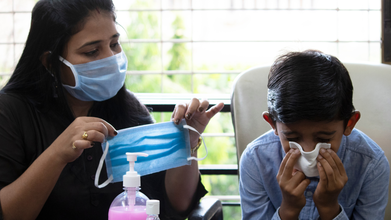- Health Conditions A-Z
- Health & Wellness
- Nutrition
- Fitness
- Health News
- Ayurveda
- Videos
- Medicine A-Z
- Parenting
Toddler Parents Are More Prone To Orthopedic Injuries, Here's How To Be Safe

Credits: Canva
Before stepping into parenthood, people often hear the familiar warnings: sleepless nights, endless responsibilities, and constant busyness. What few mention is another reality, it is the risk of injury.
Many parents have stories of physical strain, from tweaking a back while lifting a toddler to rushing across the room at night and tripping, or developing wrist pain from scrubbing bottles and pump parts. These injuries can start small but often persist for years, especially when parents overlook their own recovery while prioritizing their children’s needs.
Why New Parents Are Vulnerable
New mothers are particularly at risk due to the physical toll of pregnancy and the extra caregiving responsibilities, including breastfeeding. Coupled with lack of rest, these factors create the perfect storm for long-term issues. Experts stress that parents should seek early treatment for injuries and, ideally, prepare their bodies for parenthood with core-strengthening exercises before the baby arrives. Some compare parenting to a sport, one that demands training.
The lack of public awareness may be partly due to the absence of data. While medical billing codes exist for unusual injuries such as being struck by an animal, there is no formal category for being injured while caring for a child. As a result, the scale of the issue is difficult to measure.
From Workout to Wear and Tear
On paper, parenting could be considered a gradual fitness programme. A newborn’s weight increases steadily over the years, and play evolves from pushing a stroller to chasing a running child. But in reality, children often treat their parents as climbing frames, yanking arms or jumping on backs, leading to muscle strains and joint issues.
Physical therapists note that back, neck, shoulder, and wrist injuries are among the most common for parents. The rise in average age for first-time parents also plays a role. Older parents may face more aches and slower recovery times, similar to how an older athlete’s body responds differently to strain.
Conditions like diastasis recti, where abdominal muscles separate during pregnancy, can lead to lasting issues, including back pain, difficulty lifting, and even incontinence. Without targeted recovery, such conditions can limit a parent’s ability to care for both their child and themselves.
Changing Lifestyles, Increased Risk
Today’s parents spend significantly more time with their children compared with previous generations, reports The Washington Post. This, combined with demanding jobs, reduced community support, and a tendency to multitask while exhausted, increases the likelihood of accidents and injuries.
Stories from parents range from predictable strains to bizarre mishaps. One parent recalled dislocating a toe during a playful indoor game, which led to surgery, complications, and months of recovery. These accidents highlight how even harmless activities can result in long-term physical challenges.
Prevention and Recovery Tips
While injuries may be part of the parenting journey, there are ways to minimize the risk:
Strengthen your core: Engage in exercises like yoga, Pilates, swimming, or weight training to support the back, shoulders, and neck.
Maintain proper form: Learn safe lifting techniques for picking up children, car seats, and other heavy items.
Avoid unnecessary bending: Sit when strapping a child into a stroller instead of bending from the waist.
Travel light: Carry only essentials to reduce strain.
Slow down: Rushing often leads to missteps. Make multiple trips if needed.
Clear walkways: Removing toys and clutter reduces the chance of tripping, especially during night-time emergencies.
Adapt workouts: Short, frequent exercise sessions can replace long gym visits.
Stay active: Regular movement now will make it easier to keep up with children later.
Seek help early: Ignoring pain often worsens the injury, making recovery longer and more difficult.
Is There A Link Between Social Media Use And Increased ADHD-Like Symptoms In Kids?

Credits: Canva
Do you feel like your attention span has gone down? Thanks to multiple social media platforms and its shorter duration content, we find ourselves losing attention and cannot keep up with anything that goes a little bit over a minute. This has not just affected us, but children are now being diagnosed with attention deficit hyperactivity disorder (ADHD) more.
A latest peer-reviewed study by Karolinska Institutet, which monitored more than 8,300 US-based children from age of 10 to 14 noted that social media use has lead to increased inattention symptoms.
The researchers of the aforementioned institute in Sweden, along with the Oregon Health & Science University in the US found that children spent an average of 2.3 hours a day watching television or online videos, 1.4 hours on social media and 1.5 hours playing video games.
The study found no connection between ADHD-related behaviors, such as distractibility, and activities like playing video games or watching TV and YouTube. However, long-term social media use was linked to rising inattention symptoms in children. ADHD is a neurodevelopmental condition marked by impulsiveness, trouble focusing and frequently forgetting everyday tasks.
. According to the researchers, “We identified an association between social media use and increased inattention symptoms, interpreted here as a likely causal effect.” They noted that while the impact on each child may be small, widespread behavioral shifts could have a meaningful effect at the population level. The study also suggested that growing social media use may be contributing to the rise in ADHD diagnoses.
Why Social Media May Disrupt Focus
Torkel Klingberg, a professor of cognitive neuroscience at the Karolinska Institute, said the findings pointed specifically to social media as a factor affecting children’s ability to concentrate. He explained that platforms bombard users with constant notifications and messages, and even the anticipation of receiving one can interrupt mental focus. “This affects the ability to stay focused and could explain the association,” he said.
The research also showed that socioeconomic background and genetic risk for ADHD did not change the observed link, suggesting that the distraction-rich environment of social media itself may be responsible. Klingberg added that increasing social media use could partly explain the rise in ADHD diagnoses among children, which grew from 9.5 percent in 2003–07 to 11.3 percent in 2020–22, based on data from the U.S. National Survey of Children’s Health.
Early Social Media Exposure Raises Concerns
The authors stressed that the study does not imply all children who use social media will develop concentration problems. However, they pointed out that many children begin using these platforms well before age 13, the minimum age for apps such as Instagram and TikTok. The report called for stronger age verification measures and clearer guidance from tech companies.
How Much Time Children Spend Online
The study tracked a gradual rise in social media use, from around 30 minutes a day at age nine to about two and a half hours by age 13. The children were enrolled at ages nine and ten between 2016 and 2018. The full findings will appear in the journal Pediatrics Open Science.
Samson Nivins, a postdoctoral researcher at the Karolinska Institute and one of the study’s authors, said the team hopes the results will help parents and policymakers make more informed decisions about healthy digital habits that support children’s cognitive development.
Why A Persistent Cough In Children Needs Attention, And Ways To Strengthen Their Immunity, According To Doctor

Credits: iStock
As winter settles in and children move between school, outdoor play, and indoor gatherings, coughs and colds often become unavoidable companions. While many coughs resolve on their own, doctors warn that a cough that lingers for weeks is not something parents should overlook. At the same time, the cold season naturally weakens a child’s defenses, making it important for families to follow simple steps to improve immunity.
When a Cough Lasts Too Long
According to Dr Nishant Bansal, Consultant Pediatrician and Neonatologist at Motherhood Hospitals, Noida, parents must stay alert when a cough stretches beyond the usual duration. He explains, “A cough that lasts for weeks should never be ignored. While many are caused by mild infections, persistent or recurring coughs can point to allergies, asthma, or an underlying health issue.”
Many children are catching respiratory infections during weather changes or after starting school. As temperatures drop, coughs tend to worsen. What may look like a harmless lingering cold could actually be linked to an allergy, asthma, sinusitis, whooping cough, or even exposure to pollutants and smoke.
Dr Bansal adds, “If a child’s cough becomes worse at night, during exercise, or after exposure to dust or pets, it may be triggered by asthma or allergies. These symptoms should be reported to a doctor without delay.” Children exposed to polluted air or cigarette smoke are especially prone to constant coughing and wheezing.
Ignoring these symptoms can interfere with sleep, appetite, growth, and energy levels. Some infections, such as whooping cough or sinusitis, require prompt treatment to prevent complications. That is why early identification of the cause is essential.
Managing and Preventing Persistent Coughs
Parents often try repeated home remedies such as honey, steam, or warm fluids, but these may not be enough. “If the cough lasts more than two to three weeks, it should be evaluated instead of being managed with only home remedies,” says Dr Bansal.
Indoor air quality plays a major role. Avoid smoking around children, improve ventilation, and use an air purifier if possible. Keeping children well hydrated with warm soups, milk, or water can soothe the throat and loosen mucus. Over the counter cough syrups should be avoided unless a doctor prescribes them.
Warning signs such as wheezing, breathing difficulty, coughing fits, or fever need immediate medical care. Timely guidance helps the child breathe better, recover faster, and avoid long term complications.
Why Winter Increases Illnesses in Children
Children are naturally more vulnerable during colder months. They often face sore throats, colds, coughs, and viral infections that spread easily when people gather indoors. Dr Atul Palwe, Consultant Pediatrician and Neonatologist at Motherhood Hospital, Lullanagar, Pune, explains, “Viruses spread more easily in winter, especially when children stay in closed spaces for long hours.”
Strengthening immunity is key to helping children stay healthy throughout the season.
Simple Ways to Boost a Child’s Immunity
Focus on a Nutritious Diet
“A strong immune system begins with a balanced diet,” says Dr Palwe. He recommends plenty of fruits, vegetables, whole grains, legumes, nuts, and seeds. Foods rich in vitamin C such as oranges, guavas, and amla, along with zinc and iron rich foods, help build resistance.
Maintain Hydration
Children tend to drink less water in winter, but staying hydrated helps the body remove toxins. Warm soups and milk are comforting alternatives.
Encourage Regular Activity
Indoor games, yoga, and outdoor play on pleasant days improve blood circulation and strengthen immunity.
Ensure Adequate Sleep
“Children under ten need about ten to twelve hours of sleep every night to keep their immunity strong,” says Dr Palwe.
Teach Hygiene Habits
Handwashing before meals, after play, and covering the mouth while coughing reduces the spread of infections.
Dress Them Warmly
Layering helps protect children from cold winds while still allowing movement.
Get Enough Vitamin D
Limited sunlight in winter can affect vitamin D levels. Dr Palwe suggests encouraging morning outdoor play or discussing supplements with a doctor if needed.
Older, Younger or Middle Child: Does Birth Order Shape Your Personality?

Credits: iStock
Are you a younger sibling in your family and you relate to other younger siblings? Do you feel some of your habits and traits match other younger siblings? Or are you the middle child and you feel that sometimes you are excluded. When you talk about it, other middle children also agree with you. If this is the case with you, then you may be interested to know the Birth Order Theory.
This theory was developed by Alfred Adler in 1964, who focused on the importance of birth order on personality development. In this theory, he says that though children may be born into the same household, their birth order greatly influence their psychological development.
As per Adler's birth order theory, a child could have certain personality traits which are as followed:
- The Oldest Child: more authoritarian, and feels powerful due to high expectations set by the parents
- The Youngest Child: treated like a spoiled baby and cannot rise above the other siblings
- The Middle Child: even tempered, but has trouble fitting in as they have always been sandwiched between the younger and the older siblings
However, for middle child, their characteristics would often get itself a term, called the Middle Child Syndrome.
What Exactly Is A Middle Child Syndrome And What Sets Them Apart From Their Younger And Older Siblings?
Middle child syndrome is the belief that middle children are excluded, ignored, and neglected because of their birth orders.
People often talk about “middle child syndrome,” the idea that the child who is neither the oldest nor the youngest develops a very particular personality. While some of this comes from family dynamics rather than science, many families do notice certain patterns.
Personality Traits
Middle children sometimes feel overshadowed by their siblings. The oldest is often seen as responsible and strong-willed, while the youngest gets extra attention for simply being the baby of the family. The middle child may end up somewhere in the middle of all this, which can make them quieter, more even tempered, and sometimes unsure of where they fit in.
Family Relationships
When it comes to parents, middle children might feel that they do not get the same level of attention as their siblings. The older child usually carries more responsibility, and the younger child often gets extra care and protection. The middle child may feel they slip through the cracks and receive less one-on-one time with their parents.
Sibling Rivalry
Feeling unseen can spark a sense of competition. Many middle children find themselves competing for attention from both parents and siblings. At the same time, they often become the peacemaker of the family simply because they are used to being in the middle of everything.
Feeling Left Out of Favoritism
When parents unintentionally favor the oldest for their achievements or the youngest for their sweetness, the middle child may feel they are no one’s first pick. They are not the trailblazer or the baby, and this can shape how they see their place in the family.
Carrying These Feelings Into Adulthood
Some people believe that these early experiences can follow middle children into adulthood. If a middle child grew up feeling overlooked, they might struggle with co dependency or constantly try to keep the peace in relationships. They may also find it difficult to believe they can be someone’s closest friend or favorite person.
Their personalities often seem muted when it is compared to the other siblings, this is because they have always blended into the background. These patterns can show up at work, in friendships, and in romantic relationships.
What Research Actually Shows
Although middle child syndrome is talked about a lot, scientific research has not clearly confirmed it. There have been studies that show some truth to the theories, while others deny. Some research suggests that middle children do feel less close to their parents or are less likely to turn to their parents when they are going through stressful times in their lives. A 2019 study showed that middle children were less likely to feel comfortable talking to their parents on topics like sex education. Though it is important to note that this is a broad topic to begin with, and could have cultural variations.
Other studies have suggested they might be less family oriented or more prone to certain perfectionistic traits. But these findings are not consistent across research. In fact, a number of large studies show no strong link between birth order and major personality traits such as extraversion, emotional stability, or agreeableness.
Some studies even contradict each other entirely. For instance, one study suggested middle children might have a higher risk of depression, while another found that oldest children were more likely to experience mental health issues.
So Does Middle Child Syndrome Exist?
With so many conflicting findings, scientists cannot say for sure. Many experts believe that personality is shaped by a mix of family environment, parenting styles, cultural background, and individual temperament. Birth order may play a small role, but it is unlikely to be the determining factor.
In short, middle child syndrome is more of a popular idea than a proven scientific fact. Each child’s experience is unique, and many different influences shape who we become.
© 2024 Bennett, Coleman & Company Limited

